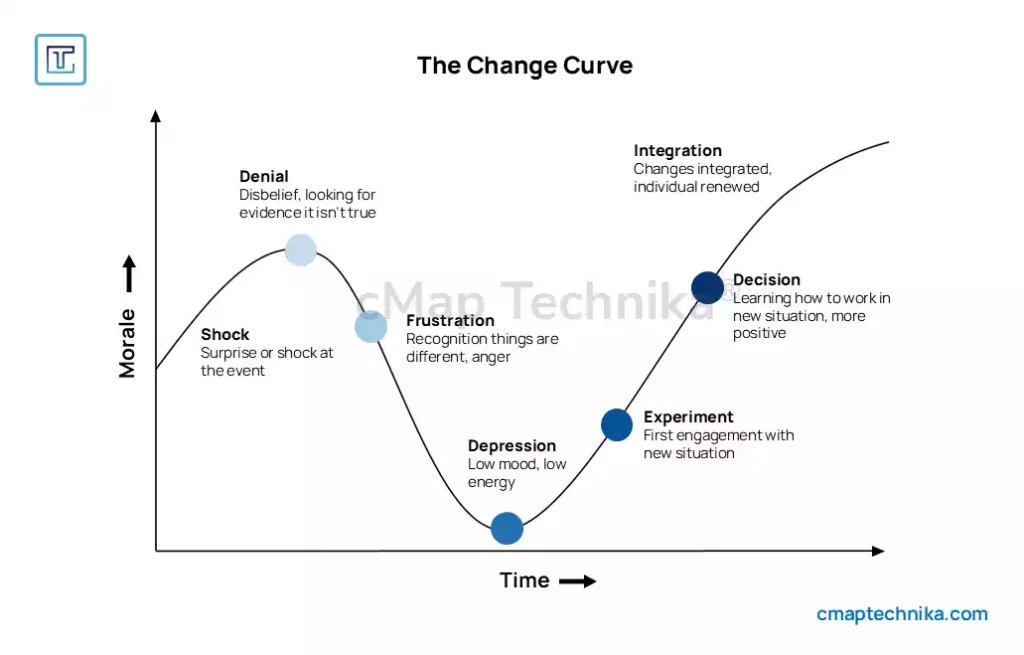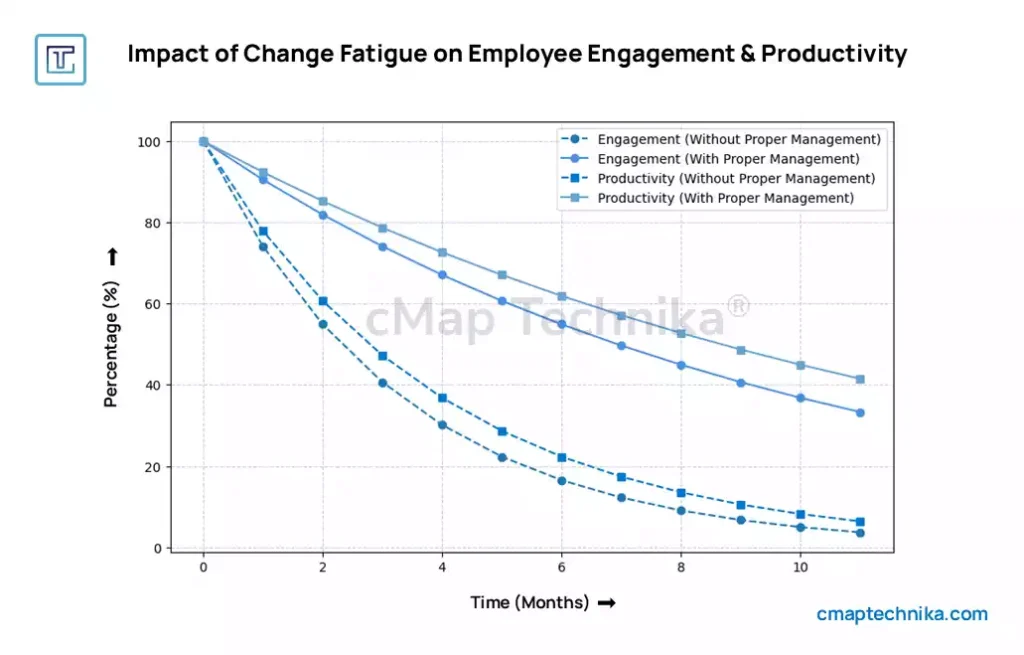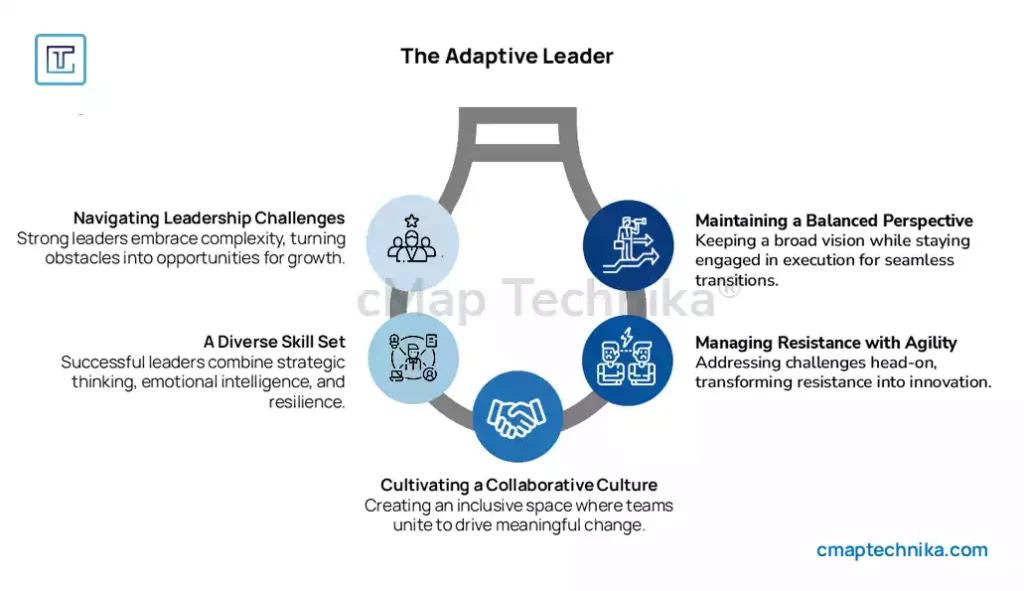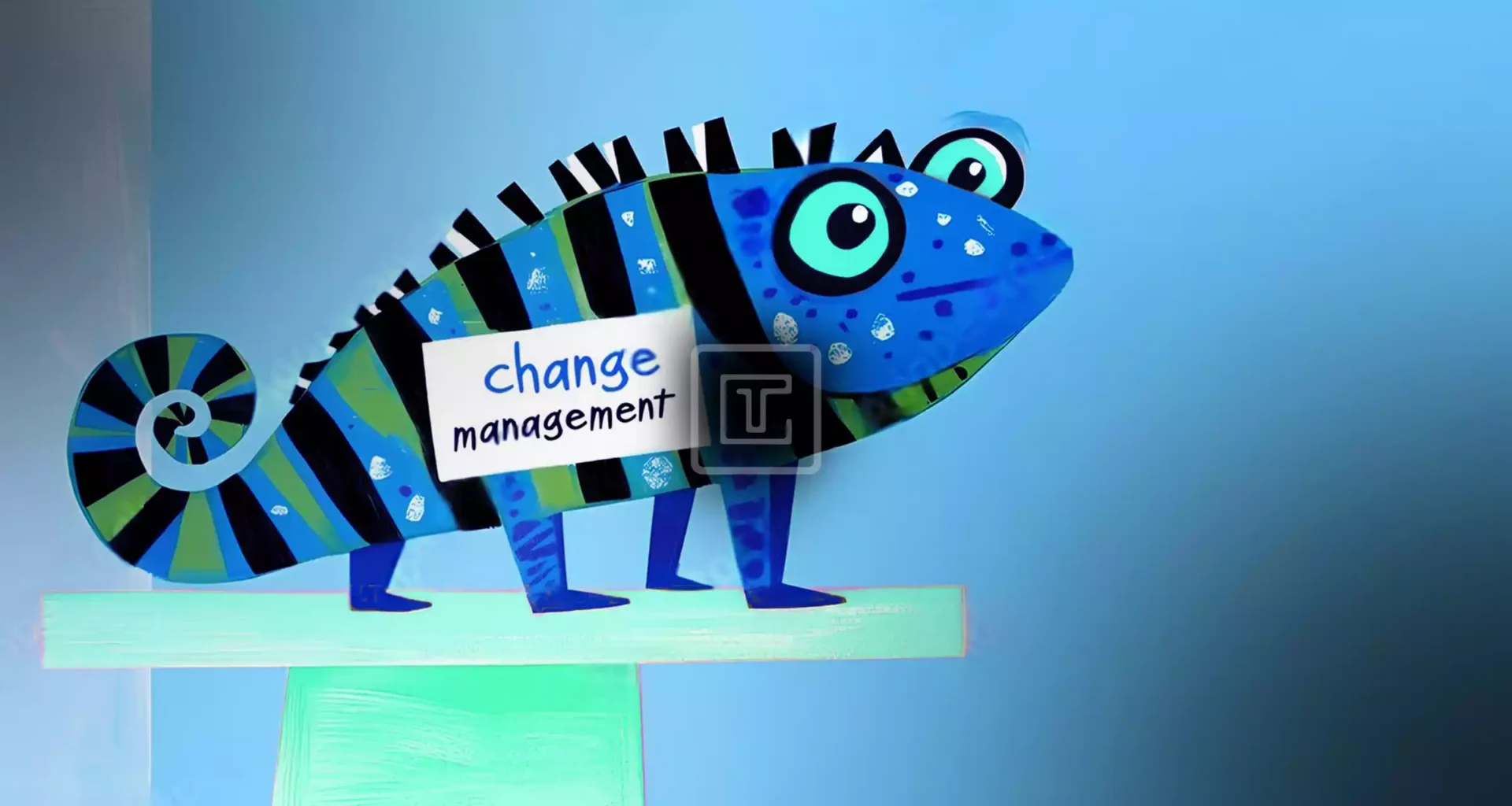Change is rarely easy. It disrupts routines, challenges deeply ingrained habits, and forces individuals and organizations to step into the unknown. Whether it’s a shift in leadership, the adoption of new technology, or an industry-wide transformation, change often triggers uncertainty and resistance. Yet, in a world where technological advancements, economic fluctuations, and evolving market demands are the norm, standing still is not an option.
The true challenge isn’t just initiating change—it’s ensuring it gains traction, overcomes resistance, and leads to lasting impact. Without a clear roadmap, organizations risk stalled initiatives, disengaged employees, and missed opportunities. This is where the Change Curve becomes essential.
Originally adapted from studies on human psychology, the Change Curve offers a powerful framework for understanding the emotions people experience during transformation. More than just a theoretical model, it provides leaders with actionable insights to anticipate challenges, support employees, and sustain momentum. How can organizations leverage this understanding to turn disruption into a driver of growth? Let’s explore.
Understanding the Change Curve

Originally adapted from Elisabeth Kübler-Ross’s model on grief, the Change Curve illustrates the predictable emotional responses people experience during transformation. These reactions typically unfold in four phases: denial, resistance, exploration, and commitment. While this model provides a roadmap, real-world applications require a tailored approach, as organizational change is rarely linear.
Each phase presents unique challenges that can impact morale, engagement, and business performance. By recognizing these stages, leaders can design targeted interventions that reduce friction, maintain trust, and drive long-term adoption of change initiatives.
The Shock of Change: Navigating Denial
The initial reaction to change is often disbelief. Employees may question its necessity, view it as a passing trend, or assume it will have little impact on their daily work. Many cling to familiar routines as a psychological defense mechanism, avoiding discussions about the change or dismissing it altogether. This phase can manifest in passive resistance—such as ignoring new initiatives—or more vocal opposition, where employees openly challenge the need for transformation.
If left unaddressed, denial can stall progress before it even begins. Leaders must take proactive steps to shift mindsets and create a foundation for acceptance.
How to Navigate This Phase:
- Communicate Early & Often: Uncertainty breeds resistance. Instead of vague promises or corporate jargon, offer clear, direct messaging about the “why” behind the change. Employees need to understand not only what is happening but also how it will impact them. Address potential concerns head-on and provide realistic expectations about the transition process.
- Identify Key Influencers: Informal leaders within the organization—whether team leads, long-tenured employees, or respected peers—hold significant influence. Engaging them as early adopters and ambassadors for change can help shift the broader organizational mindset. When employees see their colleagues embracing the change, skepticism begins to wane.
- Create a Sense of Urgency: Announcing change is not enough; employees need a compelling reason to care. Use data, industry trends, and real-world case studies to illustrate why inaction is not an option. Highlight potential risks of staying stagnant versus the opportunities that come with adaptation. Framing change as essential for long-term success can help override initial resistance.
- By taking a transparent, strategic, and empathetic approach, organizations can begin to break through denial, setting the stage for deeper engagement in the change process.
Overcoming Resistance: The Emotional Pushback

Once the reality of change sets in, emotions take over. Employees may feel frustrated, anxious, or even fearful about what lies ahead. Productivity often dips during this phase as uncertainty clouds decision-making and confidence wavers.
How to Navigate This Phase:
- Acknowledge Emotional Reactions: Resistance isn’t always rational, but it is valid. Leaders should listen to concerns, address fears directly, and reassure employees that their voices are heard.
- Provide Psychological Safety: Safe spaces for open discussions—such as town halls, Q&A sessions, or anonymous feedback channels—help employees process change without fear of repercussions.
- Equip Leaders to Lead Through Change: Middle management often bears the brunt of resistance. Investing in leadership training equips managers with the tools to navigate difficult conversations, demonstrate empathy, and guide teams through uncertainty.
The Turning Point: Encouraging Exploration
As resistance fades, curiosity takes over. Employees begin experimenting with new systems, testing processes, and considering how change might benefit them. This is a fragile but crucial period where momentum can either build or stall.
How to Navigate This Phase:
- Encourage Experimentation: Providing a sandbox environment where employees can safely explore new technologies, workflows, or strategies can accelerate adoption.
- Foster Cross-Functional Collaboration: Silos slow down transformation. Encouraging teams across departments to share insights and solutions fosters innovation and speeds up problem-solving.
- Recognize Early Wins: Progress builds confidence. Celebrating small victories—such as successful test runs or improved efficiencies—helps reinforce positive momentum and cultivates buy-in.
Embracing Change: Reaching Commitment
In the final phase, employees integrate new behaviors, and the change becomes part of the organization’s culture. However, reaching this stage doesn’t mean the work is over—sustaining change requires reinforcement and continued engagement.
How to Navigate This Phase:
- Reinforce the Change: Embedding new processes into performance metrics, KPIs, and daily workflows ensures sustainability.
- Sustain a Culture of Continuous Improvement: Organizations that embrace change as an ongoing journey rather than a one-time event foster adaptability and resilience.
- Measure Success: Tracking long-term impact through employee feedback, performance data, and market benchmarks ensures continuous refinement of change initiatives.
The Role of Organizational Culture in Change
Culture is the invisible force that shapes how employees think, behave, and respond to change. It determines whether transformation efforts will be met with enthusiasm or resistance. A company with a culture that values adaptability and innovation will likely transition more smoothly, while one rooted in rigid hierarchies and risk aversion may struggle to gain traction.
Change initiatives that ignore cultural dynamics often fail—not because the strategy is flawed, but because the people within the organization are not ready to embrace it. Leaders must assess and align the organizational culture to ensure a seamless transition.
Key Considerations:
- Assess Cultural Readiness: Before rolling out major change initiatives, organizations must gauge how prepared their workforce is to adapt. Using surveys, feedback tools, and organizational diagnostics can uncover deep-seated resistance points, allowing leaders to address concerns before they escalate into roadblocks. Understanding existing mindsets helps refine messaging and tailor support structures for different teams.
- Lead by Example: Employees take cues from leadership. If executives and managers actively demonstrate a commitment to the change—whether by adopting new processes, participating in training, or openly discussing the transformation—it reinforces credibility. Leadership buy-in isn’t just about words; visible actions set the standard for company-wide engagement.
- Recognize & Reward Adaptability: People are more likely to embrace change when their efforts are acknowledged and rewarded. Incentives such as performance bonuses, promotions, and public recognition reinforce desired behaviors. Celebrating early adopters and those who contribute positively to the transition can shift the overall mindset from resistance to acceptance, making adaptability a core part of the organization’s identity.
By embedding change into the company’s cultural fabric, organizations can move beyond short-term compliance and foster a long-term environment of resilience, innovation, and continuous improvement.
Managing Change Fatigue: Avoiding Burnout During Transformation
Sustained change initiatives can lead to exhaustion and disengagement if not managed properly. Employees may feel overwhelmed by continuous disruptions, impacting morale and productivity.
How to Prevent Change Fatigue:
- Balance Stability and Innovation: Maintain core business operations while phasing in new initiatives to avoid excessive disruption.
- Pace the Transformation: Change should be implemented in digestible phases, allowing employees to adjust gradually.
- Provide Support Mechanisms: Coaching, mental health resources, and clear guidance help employees cope with the emotional toll of transformation.
Digital Transformation: A Special Case of Change
One of the most disruptive forms of change today is digital transformation. From AI integration to cloud computing, technological shifts require not just new tools but new mindsets.
How to Overcome Digital Resistance:
- Invest in Training & Upskilling: Without the right skills, new technology can feel like a threat rather than an opportunity.
- Implement Phased Rollouts: Gradual introductions allow employees to adapt incrementally rather than facing abrupt changes.
- Address Psychological Barriers: Job security concerns are common. Transparent communication about role evolution, not elimination, is critical.
Leadership: The Driving Force of Sustainable Change

Change is not just a process; it’s an experience that requires strong leadership. Without a clear vision and steady guidance, even the best-planned transitions can falter.
Key Leadership Strategies:
- Define a Compelling Vision: Employees need to understand the broader purpose behind the change.
- Practice Empathetic Leadership: Leaders who acknowledge challenges and actively support their teams foster stronger buy-in.
- Establish Feedback Loops: Regular check-ins ensure that roadblocks are identified and addressed in real time.
Turning Disruption into Opportunity
Disruption can either destabilize an organization or serve as a catalyst for innovation and growth. The key difference lies in how change is managed. Organizations that proactively embrace change with clear strategies, strong leadership, and a culture of adaptability are more likely to thrive.
Successful change management goes beyond just implementing new processes—it requires addressing the human side of transformation. Employees must feel supported, engaged, and empowered throughout the journey. By recognizing the emotional responses to change and tailoring interventions at each stage of the Change Curve, organizations can mitigate resistance, accelerate adoption, and sustain long-term success.
To transform disruption into opportunity, leaders must foster a mindset of continuous learning and resilience. Encouraging experimentation, recognizing small wins, and maintaining open communication channels are essential for maintaining momentum. Additionally, organizations should view change as an ongoing process rather than a one-time initiative, integrating flexibility into their operational frameworks to navigate future shifts with confidence.
The organizations that thrive in times of disruption are those that prepare for change before it becomes a necessity. By building a culture that embraces transformation, businesses can turn uncertainty into a competitive advantage—ensuring not just survival, but sustained growth in an ever-evolving landscape.
Are you ready to move beyond merely reacting to change and start leveraging it as a strategic advantage? Now is the time to rethink, reimagine, and rebuild for the future.






